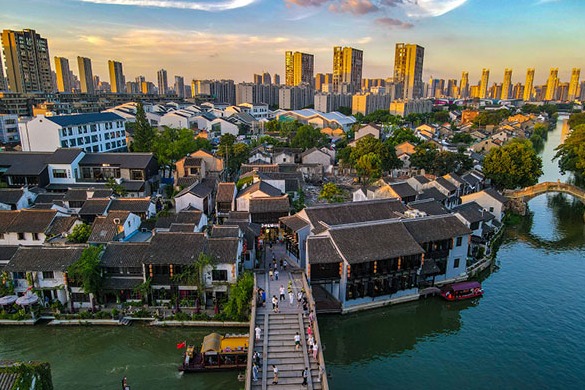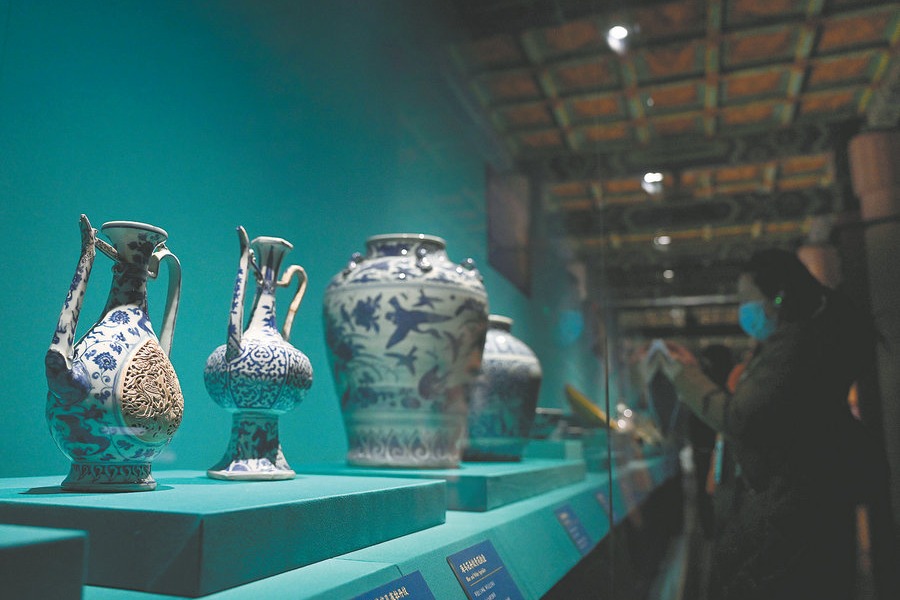Charting a course to revive cultural memories in canal hometown


On the morning of June 26, a ceremony was held for the opening of the Beijing section of the Beijing-Hangzhou Grand Canal, marking the launch of the 40-kilometer waterway for tourism, which has greatly promoted the economic development of the area.
Hearing this news turned my thoughts to my hometown in Hebei province, Gucheng county of Hengshui city, through which the Beijing-Hangzhou Grand Canal passes on its journey. In recent years, great changes have taken place in my hometown due to the protection and development of the Gucheng section by the government.
Gucheng county, on the west bank of the Beijing-Hangzhou Grand Canal, covers almost 941 square kilometers. Though small in size, Gucheng sees the Beijing-Hangzhou Grand Canal pass through seven towns and 64 villages, making the Gucheng section one of the longest stretches among many counties. The locals affectionately refer to the canal as the "Mother River", since the waterway has greatly benefited the lives of the people living there.
The Beijing-Hangzhou Grand Canal is a treasure not only to the nation but also my hometown. Yet people, including those in Gucheng county, are starting to forget its cultural value.
Urbanization has led to the accumulation of garbage and other waste piled up on the waterway by willful residents, while some even built illegal structures beside the canal. All of this has damaged the scenery and water quality of the canal, turning it into a polluted stream. Meanwhile, more people -- especially the youth -- seem to lack an understanding of the culture of the canal and the challenges involved in its construction, burying the cultural value of the waterway under the dust of time.
But the situation has taken a turn for the better. In recent years, the local government has begun paying more attention to the protection and rational development of the Gucheng section according to President Xi Jinping's belief in the protection and inheritance of cultural heritage. The local government has established a canal-themed garden, which is also a national-level water conservancy scenic spot, and a sidewalk along the Grand Canal to allow people to experience the beauty of the place while walking or enjoying recreation. In an effort to revitalize the Grand Canal, the county has enacted many new policies, such as a river chief system. A total of 70 river chiefs at county, town and village levels have been assigned to clean and renovate 59 river courses, helping the section of the canal reach its targets to eliminate pollution and control flooding.
The government, aiming to revive the cultural memories of local people in an effort to pass them on to the next generation, has designed a historical cultural block for the Gucheng section of the canal. Some historical buildings -- including the old crossings, streets and courtyards -- have been restored, forming a block with architectural styles of the Ming (1368-1644) and Qing (1644-1911) dynasties. This allows visitors to experience for themselves the thousand-year history of canal culture, creating new cultural memories that can flow from one generation to another.
Canal culture has also gotten a boost from the government with the establishment of the Grand Canal Museum in 2020 in Yangzhou, East China's Jiangsu province. The museum has 27 special exhibition halls, showing more than 1,600 precious cultural relics and artworks that reflect the history and culture along the Grand Canal for thousands of years. At the same time, each exhibition hall displays and reproduces the natural landscape as well as cultural and historical features along the Grand Canal in the form of physical objects, pictures, models and multimedia, celebrating the Grand Canal's role in the history of the Chinese nation, as well as its far-reaching impact on places such as my hometown, which has witnessed the waterway over the ages.
In May 2020, when President Xi Jinping visited the Yungang Grottoes in Datong, Shanxi province to highlight historical and cultural inheritance and exchanges, he stressed that cultural heritage is a precious resource that is not renewable and irreplaceable, and that protection should always be given top priority. Indeed, cultural heritage is very important, as it shapes our national personality, manifests the spirit of our nation and embodies our aesthetic judgment. If we forget it, we will lose our national memory and uniqueness.
Thanks to efforts by the government, this precious culture has found a new course to touch our lives once again. Though the government did much to protect the canal culture, we should always remember that every person is also its protector and inheritor. The government can help us realize its importance, but those of us who live in the region can rejuvenate it, even just through our memories.
The author is a postgraduate student at Shandong University.
The opinions expressed here are those of the writer and do not necessarily represent the views of China Daily and China Daily website.
If you have a specific expertise, or would like to share your thought about our stories, then send us your writings at opinion@chinadaily.com.cn, and comment@chinadaily.com.cn.


































